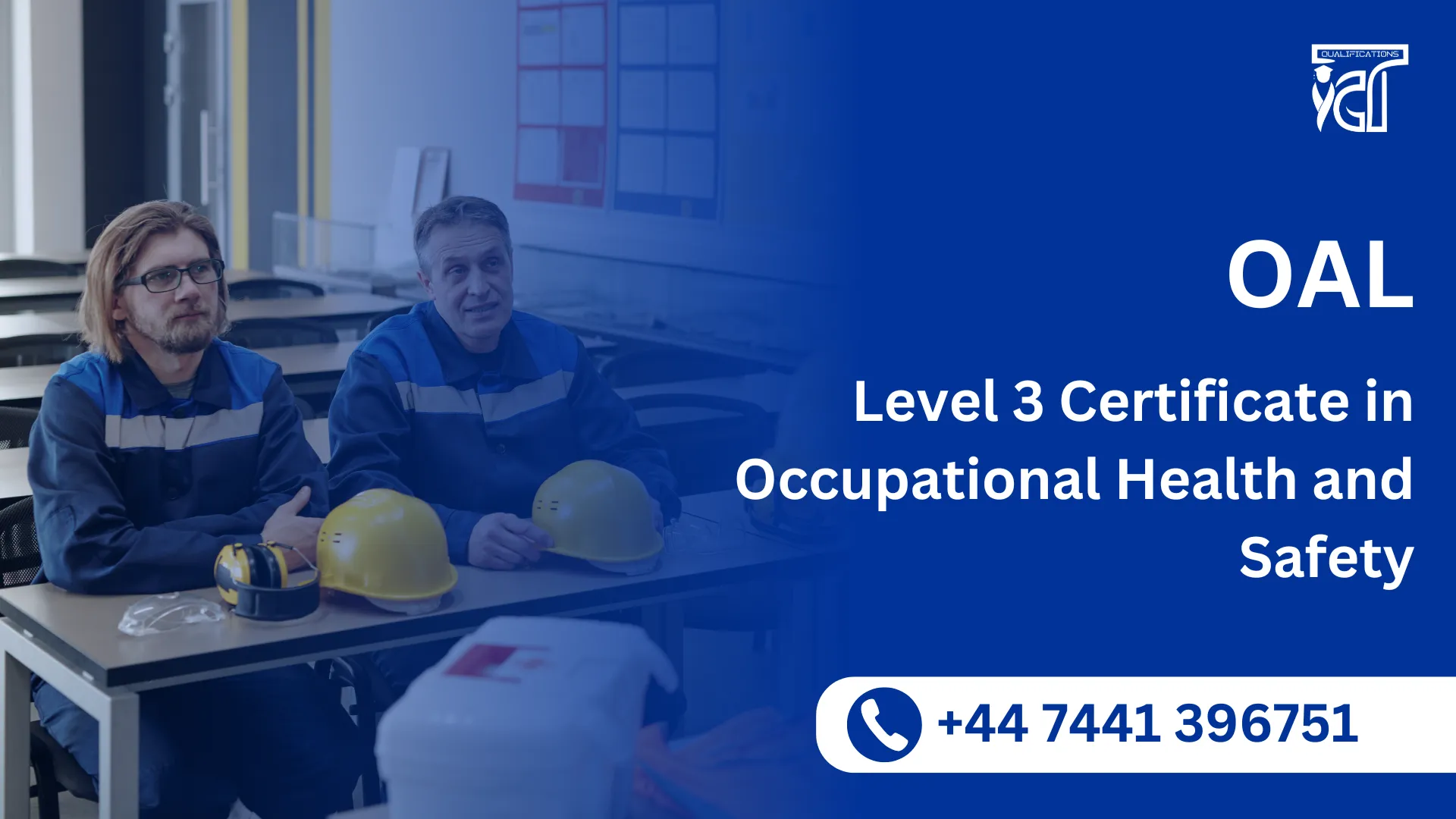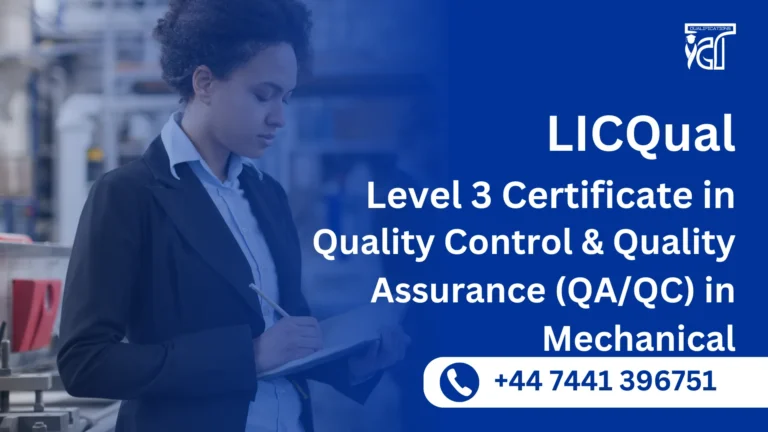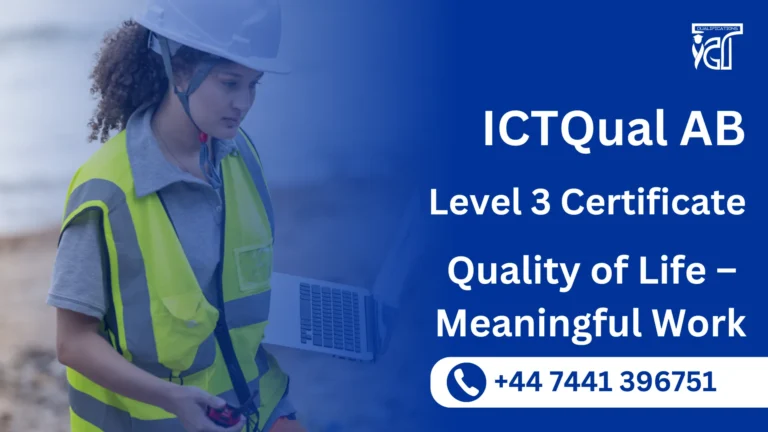The OAL Level 3 Certificate in Occupational Health and Safety is a respected qualification designed for those who are actively involved in managing workplace safety or are preparing to step into supervisory roles within health and safety departments. This certificate helps learners build a comprehensive understanding of health and safety principles, risk management, and legal responsibilities across various industries.
Health and safety is a legal and moral responsibility in every working environment. Whether in construction, manufacturing, logistics, healthcare, or office-based sectors, organisations need professionals who can identify hazards, manage risks, and create a culture of safety. The OAL Level 3 Certificate offers a structured and practical route for learners who want to develop competence in workplace safety management, fulfil legal obligations, and protect both people and business operations.
The OAL Level 3 Certificate in Occupational Health and Safety covers the essential areas of knowledge required to identify, control, and prevent hazards in the workplace. The qualification blends theory with practical application, making it suitable for those looking to manage safety procedures and policies effectively.
Learners will gain a solid understanding of safety legislation, hazard control, risk assessment, incident investigation, and performance monitoring. The course structure ensures learners not only meet compliance standards but are also capable of leading health and safety initiatives within their organisations.
The OAL Level 3 Certificate in Occupational Health and Safety is a vital step for learners committed to promoting safe working environments. With a strong emphasis on legal compliance, practical skills, and leadership in safety culture, this qualification offers both immediate and long-term value. Whether you are already working in a health and safety role or aiming to start a career in this field, this course will empower you with the skills, knowledge, and confidence to make a meaningful impact in any workplace.
OAL Level 3 Certificate in Occupational Health and Safety
The OAL Level 3 Certificate in Occupational Health and Safety consists of 7 units :
- Manage own actions to reduce risks to health and safety
- Developing procedures to safely control work operations
- Monitor procedures to safely control work operations
- Promote a positive health and safety culture
- Conduct a health and safety risk assessment of a workplace
- Investigate and evaluate health and safety incidents and complaints at work
- Supervise the health, safety and welfare of a learner in the workplace
GLH (Guided Learning Hours) and TQT (Total Qualification Time) are terms commonly used in vocational qualifications to help define the amount of time a learner is expected to spend on their studies.
1. GLH (Guided Learning Hours)
GLH refers to the number of hours a learner spends being directly taught, supervised, or supported during their course. This includes the time spent in activities such as:
- Classroom instruction
- Practical workshops
- One-on-one tutoring or mentoring sessions
- Online learning sessions with tutor support
In other words, GLH represents the time that learners are actively engaged with their instructors or learning activities.
2. TQT (Total Qualification Time)
TQT represents the total amount of time a learner is expected to invest in completing a qualification, including:
- GLH (Guided Learning Hours): Time spent on direct learning, as explained above.
- Self-Directed Learning: This includes time spent on independent study, research, assignment completion, preparation for exams, and any other work the learner does outside of direct teaching hours.
TQT is a broader measure that includes all the time required to achieve the qualification. It helps learners and employers understand the overall commitment required for the qualification.
Key Differences Between GLH and TQT:
- GLH focuses on direct learning with guidance or supervision.
- TQT includes GLH as well as independent study time and other learning-related activities.
Example:
If a qualification has a TQT of 600 hours and a GLH of 250 hours, it means the learner should spend 250 hours in direct learning (classroom, online, or tutor-led sessions) and 350 hours on independent study or research.
Upon completing this Course students will be able to:
1. Manage Own Actions to Reduce Risks to Health and Safety
Learning Outcomes:
- Understand personal responsibilities under health and safety legislation.
- Identify hazards and assess risks in the working environment.
- Demonstrate safe working practices to minimize risk to self and others.
- Follow workplace procedures and use appropriate PPE correctly.
- Report incidents, near misses, and unsafe conditions in line with organizational policies.
2. Developing Procedures to Safely Control Work Operations
Learning Outcomes:
- Understand the importance of procedures in maintaining health and safety.
- Identify legal and organizational requirements for developing safe systems of work.
- Develop clear, practical procedures to control specific work operations.
- Consult relevant personnel during the development of procedures.
- Ensure procedures are communicated effectively and reviewed regularly.
3. Monitor Procedures to Safely Control Work Operations
Learning Outcomes:
- Understand the purpose of monitoring health and safety procedures.
- Use appropriate methods to monitor compliance with procedures.
- Identify and address non-compliance and unsafe practices.
- Maintain accurate records of health and safety monitoring activities.
- Recommend improvements to existing procedures based on monitoring results.
4. Promote a Positive Health and Safety Culture
Learning Outcomes:
- Understand the characteristics of a positive health and safety culture.
- Identify the benefits of employee involvement in safety practices.
- Apply strategies to encourage safe behavior and discourage risk-taking.
- Communicate health and safety expectations clearly and positively.
- Lead by example to influence others in adopting safe working practices.
5. Conduct a Health and Safety Risk Assessment of a Workplace
Learning Outcomes:
- Understand the legal requirements for risk assessment.
- Identify hazards and those who may be affected.
- Evaluate the level of risk and determine appropriate control measures.
- Record findings in a structured risk assessment format.
- Review and revise risk assessments in response to changes or incidents.
6. Investigate and Evaluate Health and Safety Incidents and Complaints at Work
Learning Outcomes:
- Understand the importance of investigating health and safety incidents.
- Gather information using structured investigation methods (e.g., interviews, site inspections).
- Identify root causes and contributing factors of incidents and complaints.
- Produce clear, evidence-based investigation reports.
- Recommend corrective and preventive actions based on investigation findings.
7. Supervise the Health, Safety and Welfare of a Learner in the Workplace
Learning Outcomes:
- Understand the responsibilities of supervisors toward learners and trainees.
- Identify potential risks specific to inexperienced workers.
- Provide effective health and safety induction and on-the-job training.
- Monitor the learner’s compliance with health and safety procedures.
- Support the learner’s development of safe working practices and awareness.
Benefits of the OAL Level 3 Certificate in Occupational Health and Safety
The OAL Level 3 Certificate in Occupational Health and Safety offers a wide range of benefits for learners who are keen to improve workplace safety and advance their careers in health and safety management. Recognised across industries, this qualification helps learners build essential skills while meeting compliance and professional development goals.
Here are the key benefits of undertaking this course:
Nationally Recognised Qualification
- Awarded by Occupational Awards Limited (OAL), this Level 3 Certificate is aligned with UK occupational standards and valued by employers in various sectors.
Improved Workplace Safety Knowledge
- Learners gain a solid understanding of health and safety legislation, hazard identification, and risk control techniques, enabling them to create safer working environments.
Career Advancement Opportunities
- This certificate enhances employability and opens pathways to roles such as Health and Safety Officer, Site Safety Supervisor, or Compliance Coordinator.
Practical, Work-Based Skills
- The course focuses on real-world application, equipping learners with skills they can immediately apply in their current or future roles.
Supports Legal Compliance
- By learning about relevant laws and regulations, learners can help their organisation stay compliant and avoid penalties or legal issues.
Leadership and Responsibility Development
- Learners are trained to take a proactive approach to safety, lead small teams, and influence a positive safety culture within the workplace.
Versatile Across Industries
- Suitable for use in sectors including construction, manufacturing, warehousing, logistics, education, and healthcare, the knowledge gained is adaptable to multiple environments.
Foundation for Further Qualifications
- This course serves as a stepping stone to higher-level qualifications in occupational health and safety, including Level 4 and Level 5 diplomas.
Boosts Confidence and Professional Credibility
- Completing this qualification demonstrates a commitment to best practices in health and safety, enhancing credibility with employers, colleagues, and clients.
Flexible Learning Options
- Many providers offer this course with flexible learning formats, including in-person, online, or blended options, making it accessible to a wide range of learners.
By enrolling in the OAL Level 3 Certificate in Occupational Health and Safety, learners not only meet current industry expectations but also future-proof their careers in an evolving health and safety landscape.
The OAL Level 3 Certificate in Occupational Health and Safety is designed for individuals who have responsibilities related to workplace safety and are seeking to develop or formalise their skills in health and safety management. Whether working in the public or private sector, this qualification is suitable for a wide range of roles and industries.
- Supervisors and Team Leaders
Individuals who manage teams or work environments and are responsible for promoting safe working practices and overseeing daily operations. - Health and Safety Assistants
Those currently supporting safety officers or compliance teams who wish to gain formal recognition of their knowledge and progress in their careers. - Line Managers and Operations Staff
Professionals who need to understand and apply health and safety regulations within their departments or functional areas. - Site Coordinators or Foremen
Individuals involved in the coordination of site activities who must ensure safe systems of work are in place and maintained. - Employees with Health and Safety Responsibilities
Workers who are designated safety representatives or who have been assigned specific duties under workplace health and safety policies. - Career Changers or Aspiring Safety Practitioners
Those looking to enter the health and safety profession and seeking a recognised qualification to start or transition into a new career path. - Professionals in High-Risk Industries
Workers in construction, manufacturing, logistics, transport, and similar sectors where health and safety compliance is critical.
The OAL Level 3 Certificate provides a practical and accessible route for anyone looking to take on greater responsibility for occupational health and safety and contribute to safer, legally compliant working environments.
Entry Requirements
The OAL Level 3 Certificate in Occupational Health and Safety is designed to be accessible to a wide range of learners, particularly those who have responsibilities related to workplace safety or are preparing to move into such roles. To ensure that learners are well-prepared to engage with the course content, the following entry requirements apply:
- Minimum Age
Learners must be at least 18 years old at the time of enrolment. This reflects the level of responsibility and maturity expected for managing or supporting occupational health and safety in a professional setting. - Educational Background
A good standard of general education is recommended. Learners should have basic literacy and numeracy skills, as they will need to read legislation, complete written assignments, interpret data, and understand workplace documentation. - Workplace Experience
While previous experience in health and safety is not mandatory, it is highly beneficial. Ideally, learners should be in a role where they are involved in safety-related tasks, or have access to a work environment that allows them to apply what they learn during the course. - Language Proficiency
As the course is delivered in English, learners must have a sufficient level of English reading, writing, and communication skills to participate in discussions, complete assessments, and understand technical content.
These entry requirements ensure that learners are positioned to succeed in the OAL Level 3 Certificate and effectively apply their learning in real workplace situations.
Register Now
Qualification Process
Qualification Process for the OAL Level 3 Certificate in Occupational Health and Safety
- Self-Assessment:
Begin by evaluating your eligibility to ensure you meet the qualification requirements, including work experience, knowledge, and language proficiency. - Registration:
Complete your registration by submitting the required documents, including a scanned copy of a valid ID, and paying the registration fee. - Induction:
An assessor will conduct an induction to confirm your eligibility for the course and explain the evidence requirements. If you do not meet the criteria, your registration will be canceled, and the fee will be refunded. - Assignments & Evidence Submission:
Provide all assignments and the necessary evidence based on the assessment criteria outlined in the course. If you are unsure of the required evidence, consult with the assessor for guidance on the type and nature of evidence needed. - Feedback and Revision:
The assessor will review your submitted evidence and provide feedback. Evidence that meets the criteria will be marked as “Criteria Met,” while any gaps will be identified. You will be asked to revise and resubmit if needed. - Competence Evidence:
Submit final evidence demonstrating that all learning outcomes have been met. This evidence will be marked as “Criteria Met” by the assessor once it is satisfactory. - Internal Quality Assurance (IQA):
The Internal Quality Assurance Verifier (IQA) will review your evidence to ensure consistency, quality, and compliance with standards. - External Verification:
The IQA will submit your portfolio to OAL External Quality Assurance Verifiers (EQA) for final confirmation. The EQA may contact you directly to verify the authenticity of your evidence. - Certification:
Upon successful completion of all checks, OAL will issue your official certificate, confirming that you have attained the OAL Level 3 Certificate in Occupational Health and Safety.







